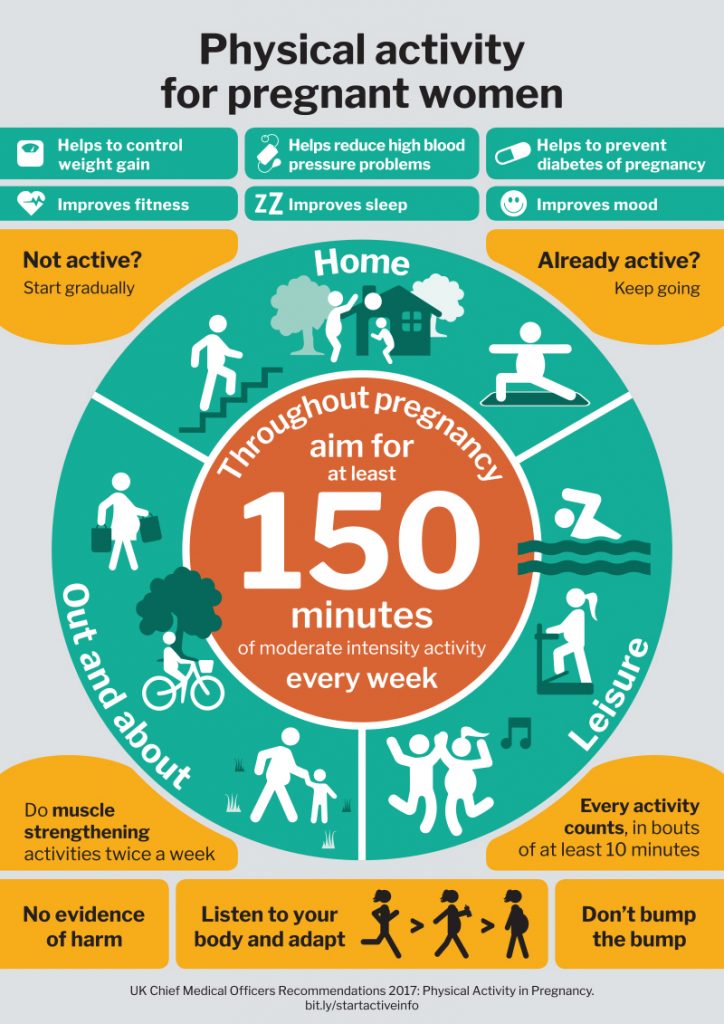We have been receiving an increased number of enquiries about exercise during pregnancy, which has spurred the launch of our pre-natal pilates classes (which start Thursday 5th March, 7:30pm). Alongside starting the classes, we also wanted to try and provide you with the information you’ve been searching for. The current recommendation is that if possible, try to continue exercising throughout your pregnancy. The government guidelines are as outlined in the following really helpful image:

What are the benefits of exercising whilst pregnant?
Whilst pregnancy is not the time to start a more intensive exercise regime, you should try to continue or modify an established routine, as this has many benefits including:
- Preparation for labour
- Decreased risk of gestational diabetes, preeclampsia, and cesarean delivery
- Maintenance of cardiovascular fitness, muscle length, & flexibility
- Improved self-confidence & body image
- Assistance in post-natal recovery
- Maintenance of healthy weight during your pregnancy
- Improved body awareness, control, & co-ordination
- Reduces back pain
- Eases constipation
Is it safe to exercise throughout my pregnancy?
If you are healthy and your pregnancy is normal, it is safe to continue with or start physical activity up to a moderate intensity. You should, however avoid contact sports, ‘hot’ pilates & yoga, scuba diving, or participating in sports at a high altitude. Our pre-natal pilates classes are specifically tailored for women in their 2nd and 3rd trimester, and we pre-assess you to ensure you are safe to participate.
If participating in our pilates classes, or any other exercise during your pregnancy, try and take a little extra care not to overheat by:
- Avoiding exercising in hot & humid conditions
- Exercising in a cool & ventilated environment
- Drinking water regularly throughout and following your exercise session
- Wearing breathable activewear

What changes in my body will affect my exercise routine during pregnancy?
Your body goes through many changes during pregnancy, so it is important to choose a form of exercise that takes this into account.
Your body will release hormones during pregnancy which cause your ligaments to relax. This makes your joints more mobile, so high-impact exercise can increase your risk of injury as your pregnancy progresses. However, continuing with strengthening exercises throughout pregnancy will help reduce your risk of injury as well as keeping your joints feeling more stable.
Your need for oxygen will increase during pregnancy, meaning you may find yourself becoming short of breath more quickly, and this may affect your ability to do more strenuous exercise. Therefore stick to exercising to a mild to moderate cardiovascular intensity. In our prenatal pilates classes we spend time working on deep breathing exercises, which can help with breathing efficiency whilst exercising throughout your pregnancy, as well as preparing you for labour.
You may find you are more likely to lose your balance as the baby grows. This is because the extra weight on the front of your body shifts your centre of gravity. This can place extra strain on some joints and muscles, especially those in your pelvis and lower back. The increased load on your back can increase the likelihood of getting lower back pain, as well as affecting your balance. Our pilates classes aim to work on posture and balance, as well as strength and stability of your joints to help prevent this during your pregnancy.

How do our prenatal classes differ from our regular pilates classes?
We pre-assess you prior to starting the class, so we can take into account your stage of pregnancy, any complications we need to be aware of, your confidence with movement, and your current fitness level. Our prenatal classes ensure the precautions of exercising in certain positions during pregnancy are complied to, and we have a greater focus on posture, stretching, and deep breathing. Our aim is for our classes to help you feel the best you can throughout your pregnancy, and prepare you for labour.
We are also thinking into the future with our classes – don’t forget you will end up with a baby at the end of your pregnancy! Therefore we work on making you strong into positions and movements you are likely to have to complete following birth – such as making your arms and shoulders stronger (for lifting and carrying the baby), keeping your legs strong (for carrying the baby up and down the stairs), and improving your core and lower back strength (for leaning over the bath, getting the car seat and pram in and out of the car).
If you would like to read more about our prenatal classes, or book your space please click here. If you have any further questions regarding our prenatal classes please click here.
***
References:
Physical activity and exercise during pregnancy and the postpartum period. Committee Opinion No. 650. American College of Obstetricians and Gynecologists. Obstet Gynecol 2015;126:e135–42. https://www.acog.org/Clinical-Guidance-and-Publications/Committee-Opinions/Committee-on-Obstetric-Practice/Physical-Activity-and-Exercise-During-Pregnancy-and-the-Postpartum-Period
Frequently asked questions – Exercise during pregnancy. American College of Obstetricians and Gynecologists. FAQ119, July 2019. https://www.acog.org/-/media/For-Patients/faq119.pdf?dmc=1&ts=20200217T1641280227
